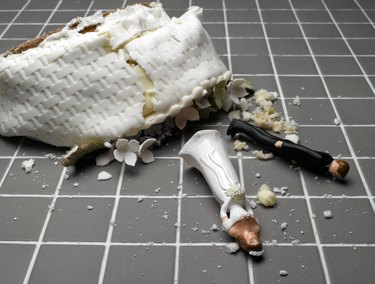
Cracked floor tiles aren't cause for immediate panic. Although cracks sometimes indicate serious structural issues, they're often a symptom of superficial damage. To discover the cause of your tile's crack, you'll need to carefully inspect the crack's size and pattern. If you suspect foundation damage after an initial inspection, you can determine the floor's prognosis by examining the structure's subfloor and the exposed portions of the foundation. An understanding of the causes of tile damage prepares you to locate problems and discuss solutions with building and repair professionals.
Isolated Cracks
Video of the Day
Cracks isolated to one tile often result from impact damage. Ceramic and porcelain tiles are particularly weak under compression and susceptible to cracks from dropped items, such as kitchenware. To confirm that a heavy impact cracked the tile, you should inspect the crack's shape. Sudden impacts usually produce cracks that resemble a spider web pattern or a break in car windshield.
Video of the Day
Cracks Along Grout Lines
Grout hugs the edges of floor tiles and sometimes seamlessly blends with the tiles' exposed surface. Occasionally, a crack along the joint between grout and tile appears to be a crack in the tile's surface. If your tile's crack seems to run along the tile's outer edge, closely inspect the crack to determine if it's really on the tile or just through the grout. If you find that the grout is cracked or peeling, you are unlikely to have foundation damage. Grout regularly shrinks and peels away from tiles if it is improperly installed or neglected.
Cracks Across Multiple Tiles
Continuous cracks that run across several adjacent tiles might indicate a shifting or settling of the subfloor beneath the tiles, particularly if the cracks run from wall to wall. Long, straight, wall-to-wall cracks warrant further inspection. You can remove the tiles yourself to inspect the underlying subfloor or call a professional for assistance. Experienced professionals often provide answers without demolishing your tile floor. If the crack runs across only a few tiles, the shifting or settling might be the result of improper mortar adhesion. When tile setters apply an uneven or insufficient layer of mortar to the tiles and subfloor, tiles sometimes shift, peel from the floor or crack under stress.
Heaving and Uneven Surfaces
Raised tiles or uneven floor surfaces on opposite sides of a crack might indicate slab foundation damage. Tiled floor surfaces generally mirror the level of their substrate. When a slab foundation heaves or settles, attached floor coverings move accordingly. If the opposite sides of your crack differ in height, you should remove the tiles and inspect the condition of the underlying foundation.